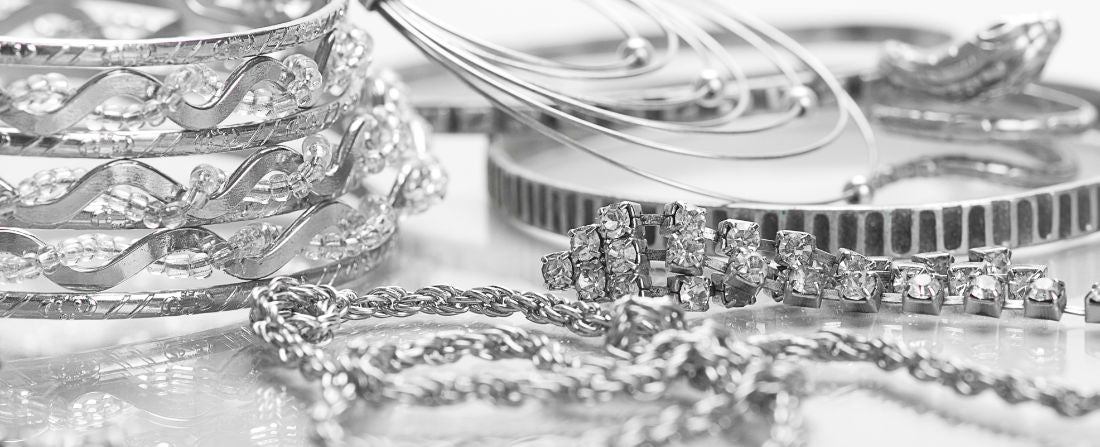You have just bought a piece of silver jewelry and engraved; you’ve discovered a number 925 on it. What is the meaning and why is that number there?
While pure silver is exorbitant, its innate softness renders it impractical for jewelry. Enter the realm of sterling silver – a blend of silver and a touch of alloy, striking the perfect balance between luxury and durability. In the vast array of silver types, including silver plate, fine silver, pure silver, nickel silver, and more, 925 sterling silver emerges as a standout player.
SIGNIFICANCE OF NUMBER 925 IN JEWELRY MAKING
The significance of "925" in the context of jewelry making lies in its representation of sterling silver. Sterling silver is an alloy composed of 92.5% pure silver and 7.5% other metals, often copper, zinc, or nickel. The numeric code "925" serves as a hallmark, indicating the quality and authenticity of the silver used in the jewelry piece.
HISTORY OF 925 SILVER
The historical significance of the "925" stamp is deeply rooted in the evolution of silver craftsmanship and trade practices. The journey of this numeric code as a hallmark for sterling silver spans centuries and reflects a fascinating narrative of standards, craftsmanship, and commerce.
Origins in Ancient Silver Trade: The roots of the "925" stamp can be traced back to the ancient civilizations of Greece and Anatolia (modern-day Turkey) around 3000 BC. In these early days, silver was a precious metal highly valued for its beauty and malleability. Merchants engaged in silver trade developed rudimentary systems to denote the quality and purity of their silver goods.
Emergence of Sterling Silver Standards: As silver gained prominence, so did the need for standardized measures of purity. The term "sterling" itself has origins in medieval England, where it referred to a specific standard of silver coinage. Over time, this concept extended to silverware and jewelry, and a numerical code—initially "925" or variations like "92.5" or ".925"—emerged to represent the precise composition of sterling silver.
Role in Silversmith Guilds: During the Renaissance, silversmith guilds began to establish strict standards to protect their craft and ensure quality. The "925" stamp became a guild-approved mark, signifying adherence to the established alloy ratio. This not only guaranteed the quality of the silver but also fostered trust among consumers, as they could easily identify authentic sterling silver.
Hallmarking in Europe: The hallmarking system gained further traction in Europe during the 14th and 15th centuries. Authorities in countries such as England and France mandated the use of specific marks to denote silver quality. The "925" stamp became a standardized symbol, indicating that the silver met the required purity standards set by these authorities.
Global Standardization in the 20th Century: In the 20th century, efforts were made to harmonize international standards for hallmarking. Organizations like the International Convention for Hallmarks played a pivotal role in establishing a unified approach to silver quality assurance. The "925" stamp, by then widely recognized, became a global standard, ensuring consistency in the quality of sterling silver jewelry worldwide.
Contemporary Significance: Today, the "925" stamp continues to carry the legacy of centuries-old craftsmanship and trade practices. It symbolizes not only the purity of the silver but also a commitment to quality and tradition in the jewelry industry. The historical journey of the "925" stamp underscores its enduring significance as a timeless hallmark for sterling silver, connecting modern pieces to a rich heritage of artistry and commerce.
DESIGNING 925 SILVER JEWELRY
As the "925" mark is an essential component of sterling silver, designers often offer customization options. This allows customers to personalize their jewelry by choosing the placement or style of the "925" stamp, making it a unique feature of their individual piece.
Contrast and Texture: Some designers leverage the contrast between the "925" mark and the rest of the jewelry. By strategically placing it in a way that complements the overall texture and finish of the piece, they create visual interest. This intentional use of contrast adds depth and dimension to the design.
Incorporating Gemstones and Other Materials: Designers may use gemstones or other materials to accentuate the "925" mark. This could involve setting small stones around the stamp or incorporating it into a larger design element. Such creative choices enhance the overall visual appeal of the jewelry.
Minimalist Elegance: In contrast, some designers embrace a minimalist approach. They integrate the "925" mark in a subtle and understated manner, allowing the simplicity to speak volumes. This minimalist elegance aligns with contemporary design trends, where less is often more.
In essence, designers view the "925" mark not as a mere technicality but as an opportunity for artistic expression. By thoughtfully incorporating this hallmark into their creations, they add layers of meaning, cultural richness, and personal stories, ensuring that each piece becomes a unique and cherished work of art for the wearer.
CHALLENGES AND COUNTERFEITS
Despite its widespread use, the jewelry industry faces challenges posed by counterfeit products attempting to replicate the "925" mark. Consumers must remain vigilant and educate themselves on the telltale signs of authentic sterling silver. In doing so, they can confidently navigate the market, ensuring that their prized possessions truly embody the quality associated with "925."
IDENTIFYING FAKE “925” SILVER
Hallmark Inspection:
- Genuine 925 sterling silver should have a hallmark or stamp, usually "925" or "Sterling," indicating its composition. Inspect the piece for these markings.
- Be wary of items with unclear or poorly stamped marks, as this can be a sign of a fake.
Magnet Test:
- Sterling silver is not magnetic, so if a magnet attracts the jewelry piece, it may not be genuine.
- This test helps distinguish between silver-plated items (which can be attracted to magnets) and authentic sterling silver.
Tarnish Response:
- Authentic sterling silver will tarnish over time due to exposure to air and moisture. If a piece looks too shiny and never tarnishes, it may not be genuine.
- Keep in mind that excessive tarnish or discoloration could also be a sign of a lower-quality alloy.
Weight:
- Sterling silver is denser than most metals used in fake jewelry. If a piece feels unusually lightweight, it may not be authentic.
- Consider the weight in conjunction with other factors, as some intricate or hollow pieces might naturally be lighter.
Pricing:
- Be cautious if the price seems too good to be true. Authentic sterling silver has intrinsic value, and significantly lower prices may indicate a fake.
- Research the market prices for similar items to gauge the reasonable cost of genuine sterling silver jewelry.
Remember, it's advisable to purchase jewelry from reputable sellers and jewelers to minimize the risk of encountering fake 925 sterling silver. If in doubt, seek the opinion of a professional jeweler for a thorough assessment.Top of Form
IN CONCLUSION OF SILVER 925
The journey of 925 in silver jewelry is not just about numbers; it's about unraveling a mystery that spans centuries, continents, and individual stories. The legacy of 925 extends beyond a mere stamp – it's a commitment to quality, tradition, and the enduring beauty of sterling silver, ensuring that each piece you adorn reflects not just craftsmanship but a timeless connection to a fascinating history. So, as you wear your silver jewelry with the discreet insignia of 925, remember that you carry a piece of history, a symbol of authenticity, and a work of art crafted to withstand the test of time.


